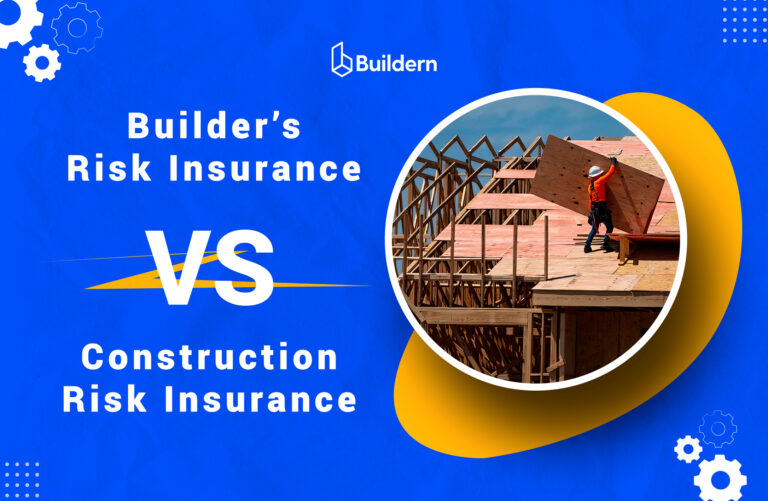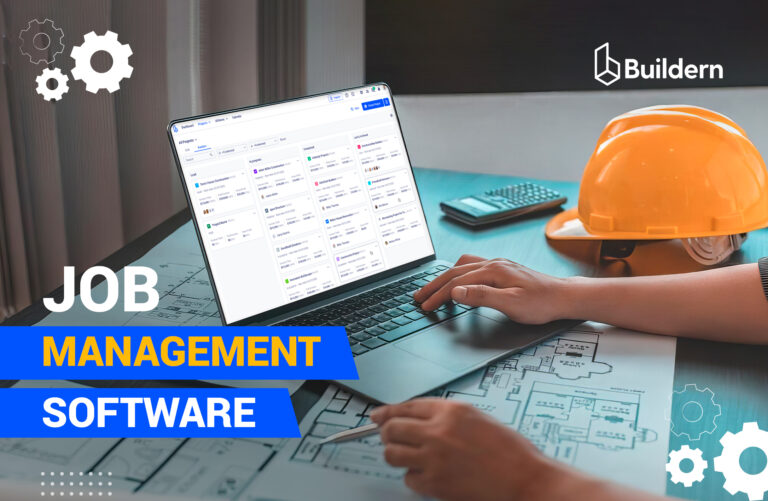Complete Guide to Construction Project Management Supremacy
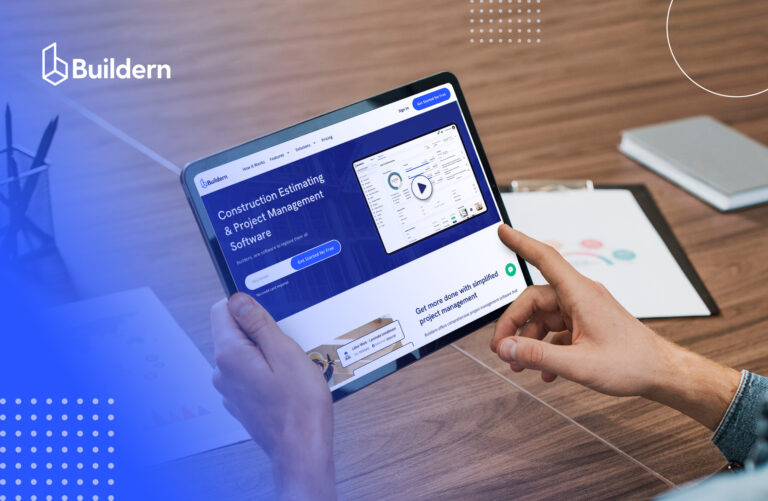
With so many moving parts and multiple stakeholders involved in the construction projects, how does everything stay on track and within budget?
The answer lies in professionally implemented construction project management strategies that bring clarity to all activities, such as estimating, planning, collaborating, and managing resources.
Without a smooth and well-organized workflow, even the most experienced industry experts will struggle to deliver satisfying results. Disruptions, miscommunications, and inefficiencies can lead to delays and compromised quality.
Let’s take a deeper look at construction management to help you avoid unwanted outcomes and create an environment where teamwork, precision, and accountability thrive.
Table of Contents
- What is Construction Project Management?
- Key Stages of Construction Project Management
- Types of Construction Projects
- Construction Roles
- Types of Construction Contracts
- Construction Project Management Software Toolkit
- Conclusion

What is Construction Project Management?
If we were to define construction project management (CPM), we could say it’s an organization of professional management techniques. Every construction project goes through a series of stages, and the role of CPM is to ensure all activities within each stage are completed efficiently and effectively.
Construction project management depends heavily on milestones and timelines that each team must meet to progress the project. It requires great attention to detail and precise cost estimation so that the end result aligns with the initial budget and client expectations.
Key Stages of Construction Project Management
For anyone outside of the industry, constructing an entirely new building almost feels like magic. But in fact, it is far from it. In reality, all projects demand hard work, effort, and very organized management strategies.
This goes through the following stages:
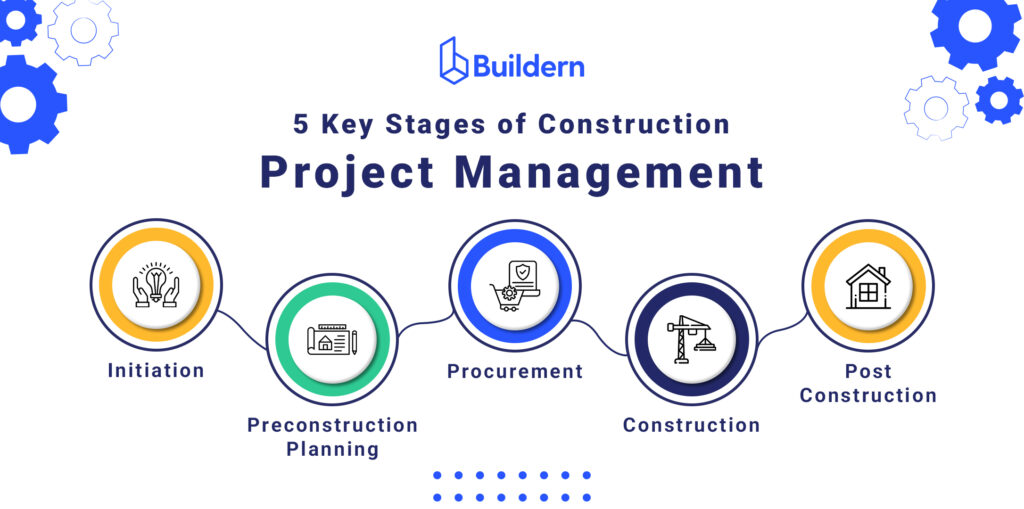
1. Initiation
Every great project starts with an idea.
Sometimes, the construction company itself will come up with a great concept. Still, more often than not, clients already have the idea prepared, and the construction company simply needs to develop them further.
There are a couple of factors the construction company should consider in these cases. First, it should understand the client’s desirable scope and then conduct a feasibility study to estimate whether the project can be completed successfully or not. During this study, the construction company should try to answer the following questions:
- Are there enough resources and a sufficient project budget to bring the project to life?
- Will the project satisfy the local safety requirements?
- Can the project be completed within the deadline?
If the initial concept passes this feasibility test, both sides can move to the next steps, which include:
- Proposal preparation for the client to approve
- Preparing a plan for the initial project execution
2. Preconstruction Planning
Once the project has been approved, construction project managers start the initial project planning by going through:
- Detailed design development and takeoff
- Estimation and preliminary budgeting
- Identification of potential project risks and creation of a risk management plan
- Sending out bid requests to their subcontractors and vendors
- Selection of subcontractor and vendor bids
Preconstruction sets the foundation of the project. It helps to identify and mitigate any challenges, sets a realistic budget, and ensures that all parties involved are on the same page before any actual construction work begins. Planning at this stage should involve multiple parties and advanced tools to automate and streamline the process.
Here are a couple of tools from our construction project management software to help you improve your preconstruction planning:
Integrated Takeoff and Estimation Tools
Buildern allows its users to estimate accurately the quantity of construction materials and labor required for a project. By leveraging digital blueprints and design plans, users can perform detailed takeoffs and transfer the gathered data into our estimation software, which uses advanced algorithms to generate precise calculations for costs, timelines, and resource allocation.
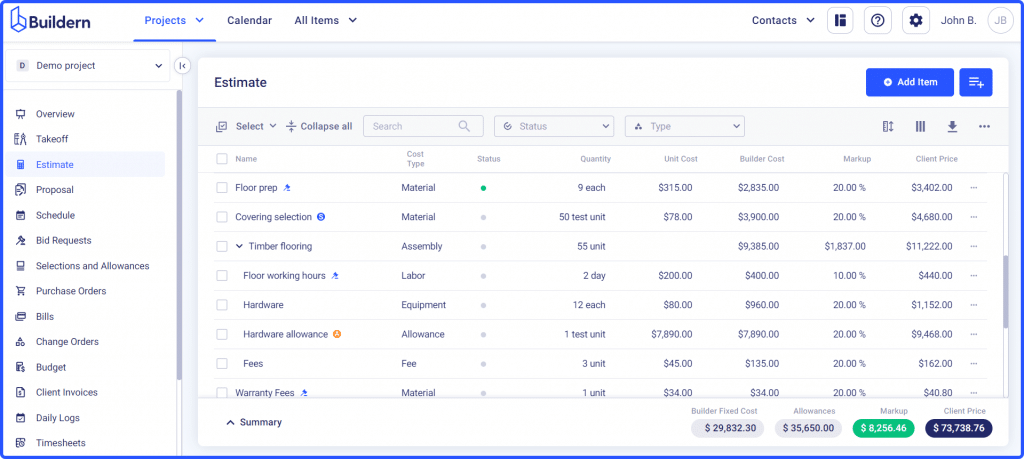
This integration not only reduces manual entry errors but also saves valuable time and ensures consistency throughout the planning process, ultimately enabling better decision-making and budget management.
3. Procurement
Construction is all about communication and working with different teams to achieve a common goal. Once the initial plans are ready, the next thing is to begin the process of acquiring the materials, equipment, and all the other resources needed. This process is known as procurement, and it involves finding the right vendors and negotiating contracts.
Collaboration is the core of the procurement process that suggests sending out bid requests and selecting vendors and subcontractors for the project.
However, managing bid requests and responses from non-Buildern partners can be time-consuming and chaotic. To streamline this process, Buildern offers the option to send bid requests through our software, allowing for easy tracking of multiple bids and their corresponding deadlines. Then, it’s up to the construction project manager to go through the subcontractors’ bids and choose the best one.
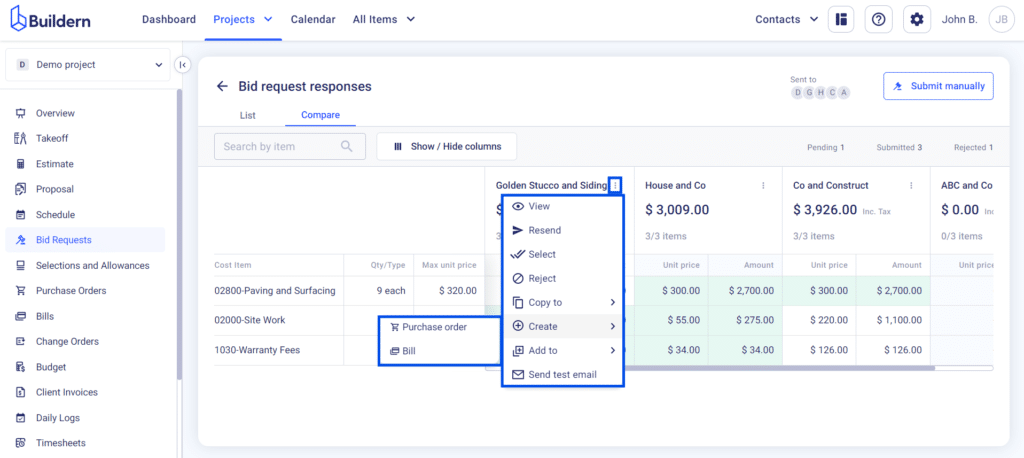
Bid Leveling Methods
Of course, the selection methods differ from company to company, but usually, it will be one of the three methods listed below.
- Low-Bid Method: Here, the PO selects the contractor who offers the lowest bid.
- Best-Value Method: In this method, the project owner does not look solely at the price bid. Instead, he analyzes the price-quality ratio. The project owner makes the decision only after examining the RFP (request for proposal) submitted by the contractors in detail.
- Qualifications-Based Method: Finally, with this method, the project owner focused on the contractor’s qualifications, analyzing each contractor’s RFQ (request for qualifications) and deciding who was the most qualified for the project.
Once the project owner finally chooses the contractor, both sides must sign a payment agreement contract to start working.
This helps with accurate cost-estimating and developing proposals that are more likely to turn into ongoing contracts. Sub/vendors can easily submit their bids online, and the data is automatically transferred into our system for further analysis.
4. Construction (Execution)
When all the planning is done, it’s time to start the work!
This is when the project management team comes together for a meeting, where all team members get to know their tasks and deadlines. During this stage, the team will:
- Identify all the required activities to complete the project
- Produce project deliverables, which then will be tested and approved by the client
Ongoing Monitoring and Controlling
Even if you’ve done your best to pre-plan everything and outline the entire project from the start till the end, you can’t lay back and forget about it. Monitoring and controlling the work is one of the essential stages of any construction project management.
This is because you might confront some unforeseen issues that need an impromptu solution. But even if nothing goes wrong, you still need to make sure that the construction crew follows the plan and meets all the deadlines.
You should also provide a project report to your client regularly. It should show precisely at which stage the project is and whether it is staying within the allocated budget and schedule or not.
Working with Daily Logs (aka Site Diaries)
Speaking of updates, it’s important to keep track of daily progress and activities on the construction site. Daily logs are great for this purpose, allowing on-site workers to document their daily activities, tasks, and any issues that may arise.

It is also important for project managers to review these logs regularly and address any concerns or delays that may affect the project timeline. This helps to maintain transparency and ensure that the project stays on track.
Financial Management
Construction projects involve a lot of money, from purchasing materials to paying workers. It’s crucial to keep track of the finances throughout all stages of construction project management. Generally, managers handle multiple financial components, including:
- Bills & Purchase Orders – Keeping track of material costs and supplier invoices
- Client Invoices – Ensuring accurate and timely billing for completed work
- Budget Control – Monitoring expenses to prevent cost overruns
Construction project management tools allow construction managers to centralize financial data and prevent miscalculations.
5. Project Closeout (Post-Construction)
Last but not least, the final stage of construction project management is project closeout. This involves completing all remaining tasks, finishing up documentation, and handing over the finished work.
It’s a rather stressful and no less responsible period when all stakeholders involved in the project must ensure that everything is completed successfully and to the client’s satisfaction.
Project closeout typically includes:
- Final inspections and obtaining necessary documentation from all the subcontractors, like warranties or lien waivers.
- Tracking all the change orders to ensure the project stayed within budget and the reasons for all changes are documented.
- Handing over all necessary project documents to the client, including manuals, warranties, as-built drawings, final reports, and other relevant information.
- Conducting a final walkthrough with the client to ensure their satisfaction with the project and address any remaining concerns.
- Finalizing all financial aspects, including submitting final invoices and reconciling any outstanding costs.
Types of Construction Projects
Although there are many different kinds of construction buildings, the six main types of construction projects include:
- Residential Building
- Institutional and Commercial Building
- Specialized Industrial Construction
- Infrastructure and Heavy Construction
- Environmental Construction
- Agricultural Construction
Let’s quickly skim through all of them:
1. Residential Building (Construction and Renovation/Modeling)
Residential construction aims to build, repair, and remodel structures to house people.
Apartments, townhomes, condos, nursing homes, and dormitories are all examples of residential buildings. Even the installation and repair of garages or utility outbuildings for water and electricity supply are considered residential constructors.
What specialists are usually involved in this type of construction?
Well, in the execution phase, there are architects who are professionals in building design, as well as engineers who are skilled professionals who invent, analyze, and test various complex systems and structures, from building to software.
Most construction companies usually hire subcontractors to do the project’s mechanical, structural, and electrical work. However, some companies prefer to handle all house design and construction phases themselves.
2. Institutional And Commercial Building
Institutional and commercial buildings are built to serve society’s needs, and they are managed either by the local or national government or the private owner. These projects include schools, stadiums, sports arenas, retail stores, shopping centers, hospitals, and restaurants.
These construction projects typically involve starting new buildings and repairing or remodeling the existing structures. Considering the structure’s scale, we can divide the commercial constructions into small, medium, and large scales.
Large-scale commercial constructions always start from an architect’s newly developed and designed structure, usually based on the version of the business owner. Here, the project scope is really large. These projects require a lot of time and sometimes costly preparations, like demolishing an older building.
Medium-scale constructions deal with restructuring, expansions, or additions of structures or remodeling. Small-scale projects are typically less costly and require a minimum number of workers. These are usually office space redesigns, structure updates, and building repairs.
3. Specialized Industrial Construction
Specialized industrial construction is the next on our list. It is called “specialized” as these construction structures are, as you could have guessed, specialized in a specific field. For instance, when a private company in the power generation field builds nuclear power plants and hydroelectric power plants, it is considered a specialized industrial construction.
Overall, this construction type usually deals with manufacturing plants, refineries, solar and wind farms, or power plants. Therefore, it requires a high level of technical skills so that it satisfies industry demands. It also results in high construction costs, so not every company can afford it.
These types of projects are also among the most difficult ones in the construction industry. The client usually needs the project to be completed on a tight deadline while requiring the highest quality possible.
4. Infrastructure And Heavy Construction
Infrastructure construction projects, also called civil construction, include structures like airports, bridges, roads, highways, tunnels, and transit systems.
This type of construction is in the public’s interest and gets implemented by government agencies. However, some prominent private corporations may be involved too.
5. Environmental Construction
Considering the state of our planet, this one is among the most important types of construction. The environmental construction projects draw particular attention to ecological aspects. Its primary mission is to reduce pollution and offer environmentally friendly solutions.
Dams, systems for recycling and reusing construction waste, systems built to reduce air pollutants, and facilities for wastewater treatment are all examples of this construction type.
6. Agricultural Construction
Finally, we finish our list with agricultural types. As the name suggests, this type of construction is usually done in the interest of farms or other agricultural companies.
These projects demand a specific approach, as before starting construction, the company should carefully research the market and analyze its volume. The construction process also includes finding the appropriate land, which is one of the biggest challenges here.
Sometimes, the agricultural and environmental constructions merge together when the agricultural companies decide to increase the energy efficiency of their project by building a solar power station or coming up with similar eco-friendly alternatives.
Construction Roles
The management of the construction needs a great team of experts. For those wondering how to get into construction project management, let’s take a look at the most popular construction roles.
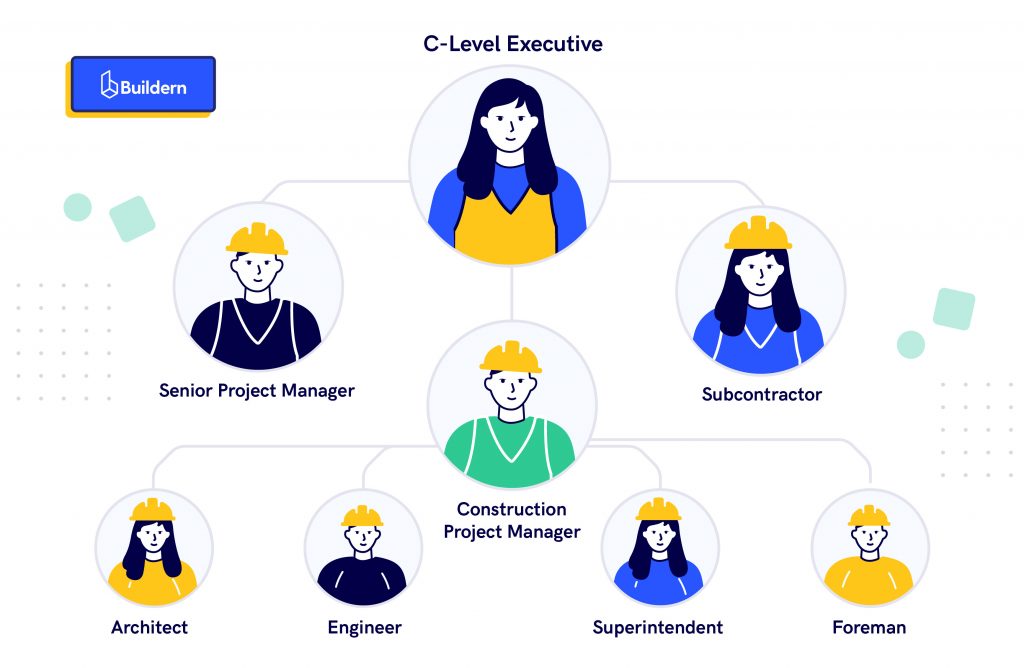
C-Level Executives
Overseeing business strategy, financial planning, and high-level decision-making within the construction firm, c-level executives include CEOs, CFOs, and COOs who manage the company rather than deal with separate projects.
Construction Project Managers
These are people who plan, coordinate, and supervise the entire project lifecycle. They are actively involved in tasks like scheduling and budgeting to ensure all the operational and administrative tasks are completed according to plan.
Construction project managers are actively involved in communication with clients and subcontractors or vendors. Their goal is to ensure the project is delivered on time, within budget, and meets all specifications.
Architects and Engineers
No construction project can survive without architects and engineers. Designing the structure and ensuring its compliance with safety, functionality, and regulatory requirements, these specialists collaborate to ensure the outcome meets all the expectations.
Superintendents
Acting as the on-site managers, superintendents align the daily operations with project plans, schedules, and safety protocols. They coordinate directly with field workers and subcontractors.
Field Workers
These are the skilled tradespeople responsible for executing the physical construction, including electricians, plumbers, carpenters, and heavy equipment operators.
Subcontractors & Vendors
Sub/vendors are the specialized professionals or companies hired by the general contractor to complete specific tasks, such as electrical work, plumbing, or material supply.
Each of the listed and other roles contributes to the overall efficiency, safety, and quality of a construction project. Check our extensive guide to learn more about the construction project team structure:
Types of Construction Contracts
For every construction project, it’s essential to ensure smooth work and payment processes in the project initiation phase. That’s why there are different types of construction contracts that meet the requirements of all project participants.
As with any other contract, the construction contract is just an agreement between project parties to provide services in compensation for payment. It is one of the most important project documents.
As mentioned, construction companies usually have a clearly defined hierarchy, so each party involved in the construction process will have a contract with the other: for example, the owner with the general contractor, the general contractor with a subcontractor, etc.
The construction contract should include:
- The general conditions of the involved parties
- The detailed scope of work
- The project timeline
- The payment terms
Additionally, the contract should clarify the rights and responsibilities of all parties. It may also include many other documents that explain the conditions.
Though the contract parties are free to choose any terms they want in their agreement, there are mainly three types of contracts in the construction industry.
- Fixed-price contracts
- Time and material contracts
- Cost-reimbursement contracts
Fixed-Price Contract
This type of contract is the most popular. It is also known as a lump sum contract because the whole work is charted under one fixed price. It has both benefits and disadvantages.
Advantages of Lump Sum Contract
The owner and the general conductor start a bidding process to begin any construction project. So, it’s easier to negotiate one total price instead of submitting different bids.
This type of contract also allows you to save your project budget. When you complete the construction in time and under a precisely estimated budget, you don’t have additional expenses, which means what is left is the profit.
Disadvantages of Lump Sum Contracts
Accurate calculation and cost control is the key to success. Any failure and miscalculation will be reflected in the budget. And the bigger the construction, the more specialists will be involved in the process, so the chances of money loss will increase.
To avoid that, at the beginning of the project, one should account for unexpected costs or delays.
Overall, considering the benefits and disadvantages, we can conclude that lump sum contracts are usually suitable for small projects with a predictable project scope.
Time and Material Contracts
Time and material contracts are implemented if the project scope is not accurately defined and there is no exact payment rate for the materials’ cost.
Advantages of Time and Material Contracts
These types of contracts are really agile, as the customer reimburses the contractor the cost of the materials and pays an hourly wage. This means all the unexpected delays, roadblocks, and changes will be covered.
Also, Time and Material Contracts set easy rules for negotiations between both sides. For example, you can easily decide on the hourly wage and which materials will be covered.
Disadvantages of Time and Material Contracts
To calculate each material cost correctly, one needs a lot of time. So this is one of the main drawbacks of the contract: if you spend so much time counting the material cost, in the end, the result may not be justified.
Another disadvantage is that even if you finish the project early and get ahead of schedule, your company will not get any bonuses, salary raises, or awards. Pretty sad, isn’t it?
Moving to the:
Cost-Reimbursement Contract
This type of contract is also called the Cost Plus contract. It is usually used for projects that require a lot of creativity. And as with any creative process during these projects, many ideas arise, which bring unforeseen expenses.
This contract mainly has two parts: the fixed fee which the sides have agreed upon and the additional costs that arise during the project’s progress.
Cost Plus contracts cover all the human and material resources: both direct costs like labor and materials and indirect costs like renting an office, traveling, and other administrative expenses.
Advantages of Cost Plus contracts
The Cost Plus contracts are really flexible as they allow the owners to change the initial design along the way, knowing that they will still be paid for the extra materials and time.
An advantage of these contracts is that miscalculations are not as devastating as in other cases. There can be minor inaccuracies in the initial bid; it won’t become a big problem anyway.
Disadvantages of Cost Plus contracts
The main disadvantage of these contracts is that sometimes, the contractors might force the construction company to justify certain costs and expenses. And alas, some costs might be hard to account for.
Other than these three main contract types, there are also Unit Price contracts and GMP contracts, both of which are pretty popular.
- Unit Price contracts: These contracts are used when the costs cannot be determined ahead of time, so the materials are set with unit prices.
- GMP contracts: GMP stands for the guaranteed maximum price contract. It works with the same principle as the Cost Plus contract; only the contractors define the maximum price here.
Construction Project Management Software Toolkit
The best tool for project management is software designed specifically for the construction industry. Today, so many things need to be tracked and taken care of in large projects that it’s impossible to imagine that all of that can be done manually. So, having one is no longer optional: it’s mandatory to keep your project organized and stay on track.
But how do you really choose the best construction project management software?
First, you should make sure that it offers a centralized system. This way, everyone can access the construction project whenever they want to and get the latest updates. It is especially important for your clients, as it ensures transparency.
We also advise finding software that accepts project-based payments and even allows you to try it for free until you get your first contract.
Overall, look for an all-in-one software that will be easy to use and offer hundreds of features that will help you scale in all your projects.
Buildern offers all of it and is the perfect choice for all types of construction companies. No matter at which stage your business is, Buildern will have an appropriate package to help you get the most out of your construction project management.
Conclusion
Construction project management is pretty complicated, but the results are absolutely worth it if you do it right. In the end, don’t overthink it. Get yourself the right tools, pick a good team, and start working. Overall, keep in mind that you have to constantly keep your eye on the project and communicate with team members and stakeholders. Everything else will move with its own flow.
And while on it, don’t forget to check out what’s going to be trendy this year to make your construction project even more outstanding. From AI technologies to 3D printing, there is so much that can help you to take your project to the next level, but as a first step, we advise you to get yourself cloud-based software and get all of it organized.
Don’t worry, it won’t cost you a fortune. In fact, you can start using it right now, with our free plan at Buildern.

